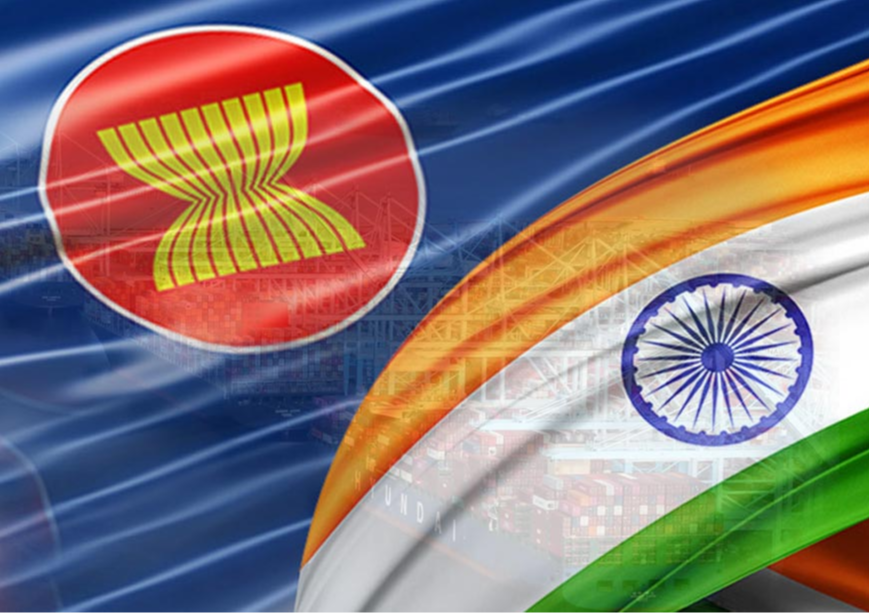-
CENTRES
Progammes & Centres
Location
As India’s competitive efforts to augment itself as a global manufacturing hub expand, AITGA’s future success is critical to addressing its unfavourable position in the ASEAN supply chain.

In 2022-23, ASEAN constituted 11.3 percent of India's global trade. However, India has experienced a growing trade deficit amounting to approximately US$7.5 billion annually since the inception of the ASEAN-India Trade in Goods Agreement (AITGA) in 2010. With exports valued at US$44 billion against imports worth US$87.57 billion, this deficit surged significantly to US$43.57 billion in 2022-23. The spiralling trade deficit (US$17.51 billion in the last fiscal year against US$25.76 billion in 2021-22) calls for an urgent reassessment of the existing trade framework.
The Ministry of Commerce is aggregating inputs from diverse stakeholders ahead of the forthcoming AITGA review, which is projected to enhance Rules of Origin (RoO), amongst other measures. With the review negotiations set to conclude in 2025, India aims to curb avenues from third-state parties to exploit preferential tariffs.
Within five years of the AITGA’s enactment, India initiated discussions to review the pact due to the surge in imports from ASEAN and the failure to realise the anticipated benefits weighed against AITGA’s tariff relaxations. Moreover, Indian export patterns do not complement the import patterns of several ASEAN states. Significantly, while RoO complexities and loopholes have complicated the supply chain, sharp competition over the global market share for apparel, steel, auto components, etc., has made the supply chain incoherent.
With the review negotiations set to conclude in 2025, India aims to curb avenues from third-state parties to exploit preferential tariffs.
The influx of Chinese products into Indian and ASEAN markets has also undermined AITGA’s intended benefits. India is apprehensive of the high possibility of importers violating RoO norms and exploiting its loopholes for cheap imports via the ASEAN. Already, there have been instances of round-tripping imports, where goods are rerouted from China through ASEAN channels to India—for example, the inflow of cheap Chinese mobile phones via Malaysia. China and other non-member states like Japan and South Korea are setting up new entities or acquiring defunct companies in countries like Vietnam to escape domestic tariffs on their exports to India through these shell enterprises and re-levelling their products.
RoO traces and verifies the origin where a product is sourced or “substantially transformed”. While ensuring goods made only in member states get FTA customs benefits and stipulated low tariffs, RoO also provides for barring trade diversion from third states through FTAs. They set the criterion for the substantial transformation extent and local processing extent that the exporting member state must undertake to claim preferences under an FTA.
India introduced the Customs (Administration of Rules of Origin under Trade Agreements) Rules 2020 (“CAROTAR”) to regulate domestic importers and curb the influx of Chinese products claiming fraudulent AITGA exemptions under the guise of ASEAN exports.
CAROTAR mandates the supplier to provide the Indian purchaser with a Certificate of Origin (CoO) from the issuing authority in the exporter’s state, confirming the product’s origin for import validation. Further, it lays down a nuanced procedure for claiming preferential duty and verification with circumstances prescribing rejection of claims.
CAROTAR mandates the supplier to provide the Indian purchaser with a Certificate of Origin (CoO) from the issuing authority in the exporter’s state, confirming the product’s origin for import validation.
If goods from a particular exporter or producer are found deficient in the origin criteria, this determination will also affect identical goods from the same exporter or producer. For instance, if producer X in state A manufactures televisions and refrigerators, and verification shows that X's production process doesn't meet the required criteria for refrigerators, this outcome will also apply to future imports of refrigerators from state A produced by X. However, this deficiency does not affect televisions made by producer X or refrigerators made by other producers in state A. This mechanism, akin to blacklisting, induces greater accountability amongst trade partners and foreign players.
As CAROTAR obligations stem from the domestic regulatory regime, an importer must comply with them irrespective of their consonance with trade agreements. At the same time, CAROTAR provisions concerning origin are being made consistent with FTA via RoO notifications empowered by the Customs Tariff Act. In any event, CAROTAR asserts that RoO provisions will prevail in the conflict between an FTA and domestic law.
CAROTAR faced objections from ASEAN members like Indonesia, as its prolonged verification and clearance processes disrupted the trade cycle. Despite these objections, India has maintained CAROTAR to scrutinise importers employing ingenuine certificates, non-disclosures and other methods to claim FTA preferences.
India has stressed the need for granular and product-specific rules of origin in the AITGA, aligning with ongoing trade negotiations that emphasise varying degrees of value addition for different products. However, significant enhancements are imperative in AITIGA's RoO procedures. For example, the extant bifurcated criterion calls for 35 percent regional value addition and tariff subheading alteration, resulting in excessive documentation without fortifying standards. Adopting ASEAN's uniform value addition threshold of 40 percent, as exhibited in the China-led Regional Comprehensive Economic Partnership (RCEP), would streamline rule administration. Furthermore, establishing product-specific RoO for key Indian exports, such as refined petroleum and diamonds, is essential to capitalise on tariff concessions. Accommodating flexibilities for specific non-originating inputs in fishery exports will also be beneficial.
The ongoing AITGA review has considered RoO reforms as witnessed in the India-UAE Comprehensive Economic Partnership Agreement (CEPA) and India-Australia Economic Cooperation and Trade Agreement (INDAUS ECTA), where penalties or sanction for misrepresentations can be imposed on exporters. These agreements impose specific obligations on exporters, producers, and manufacturers to maintain information and supporting documentation for five years, with the records subject to inspection. Moreover, the importer is incentivised through CAROTAR to procure these disclosures, possess ‘sufficient information’ concerning product origin and show ‘reasonable care’ through due diligence before claiming CoO.
Adopting ASEAN's uniform value addition threshold of 40 percent, as exhibited in the China-led Regional Comprehensive Economic Partnership (RCEP), would streamline rule administration.
With India expanding its regional economic integration in the FTA sphere well beyond its “Act-East” policy, a tighter grip on RoO is expected for AITGA negotiations. However, the complexities of multifaceted RoO can cause domestic businesses to incur additional trade expenses, logistics and administrative costs. Businesses often prefer a flexible regulatory regime to facilitate free trade flow, prompting them to opt for traditional trade routes instead of the FTA route, where the tariff benefits are marginal (below 10 percent). Therefore, stakeholder engagements are pivotal to strike a balance. Stakeholders must align with global standards, such as consideration of harmonised commodity descriptions (HS codes 2022) introduced by the World Customs Organization. Mapping the value chain of each product category, where stakeholders can project the alterations induced by trade agreements, is imperative.
India contends that non-reciprocity in FTA concessions, non-tariff barriers, import regulations, and quotas have hindered its exports to ASEAN.
Infrastructure shortages and susceptibility to income changes constrain India’s trade benefits, disproportionately impacting exports. The abundance of Chinese products in Indo-ASEAN markets undercuts AITGA's potential. The ASEAN-China FTA, on the other hand, gives China easier access to ASEAN markets than India. Meanwhile, incentivising the “China plus one” approach can boost ASEAN’s manufacturing prowess. India’s AITIGA review must consider these shifts to recalibrate its trade strategy effectively.
The Customs Bonded Warehouse Scheme enables an enterprise to import products with deferred customs duty while manufacturing goods in the customs bonded warehouse.
Besides a robust regulatory regime, proactive executive mechanisms are required to attain AITGA’s success. Steps such as introducing a common digital platform for CoOs, Trade Infrastructure for Export Scheme (TIES) and Market Access Initiatives (MAI) Scheme have been undertaken at the executive level. The Customs Bonded Warehouse Scheme enables an enterprise to import products with deferred customs duty while manufacturing goods in the customs bonded warehouse. Such enterprises are incentivised by zero interest liability and no threshold requirement for export volume.
India’s global imports during the 2010-21 period rose by 63 percent, but imports from ASEAN alone grew about 120 percent. With India recently extending a 12-point proposal at the 20th ASEAN-India Summit and the 18th East Asia Summit, including sharing India’s Digital Public Infrastructure Stack with ASEAN partners, modernising AITGA is paramount to strengthening the India-ASEAN partnership. As India’s competitive efforts to augment itself as a global manufacturing hub expand, AITGA’s future success is critical to addressing its unfavourable position in the ASEAN supply chain.
Dharmil Doshi is a Research Intern at the Observer Research Foundation
The views expressed above belong to the author(s). ORF research and analyses now available on Telegram! Click here to access our curated content — blogs, longforms and interviews.

Dharmil Doshi was a Research Assistant at ORF’s Centre for New Economic Diplomacy, where his research spans international commercial law (encompassing treaties and conventions, foreign ...
Read More +